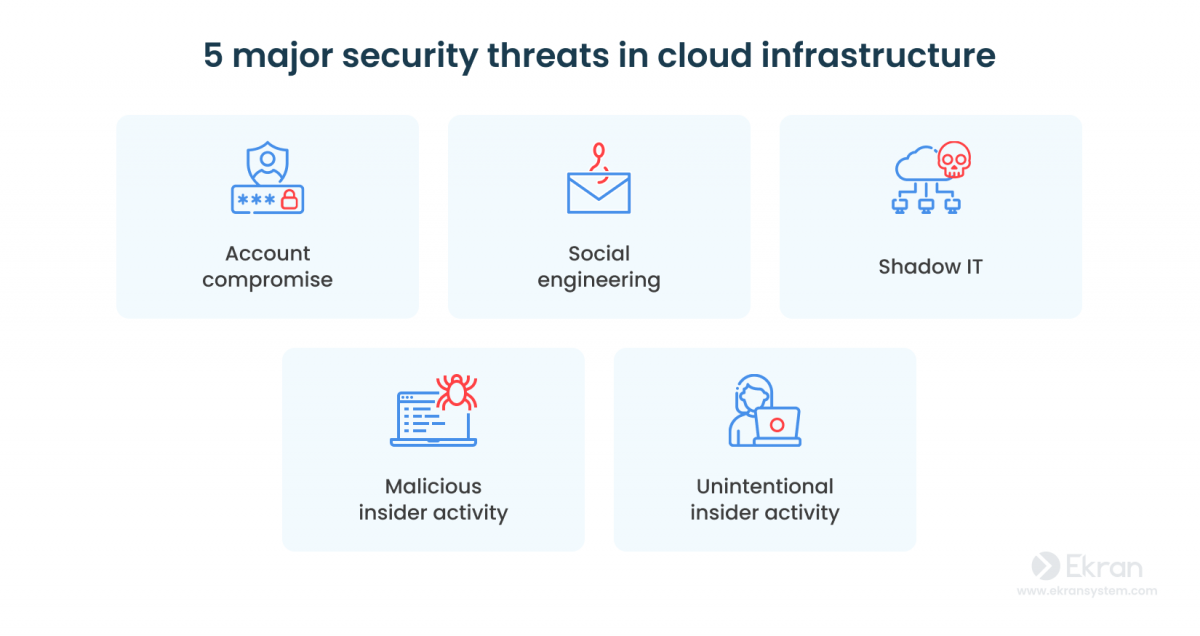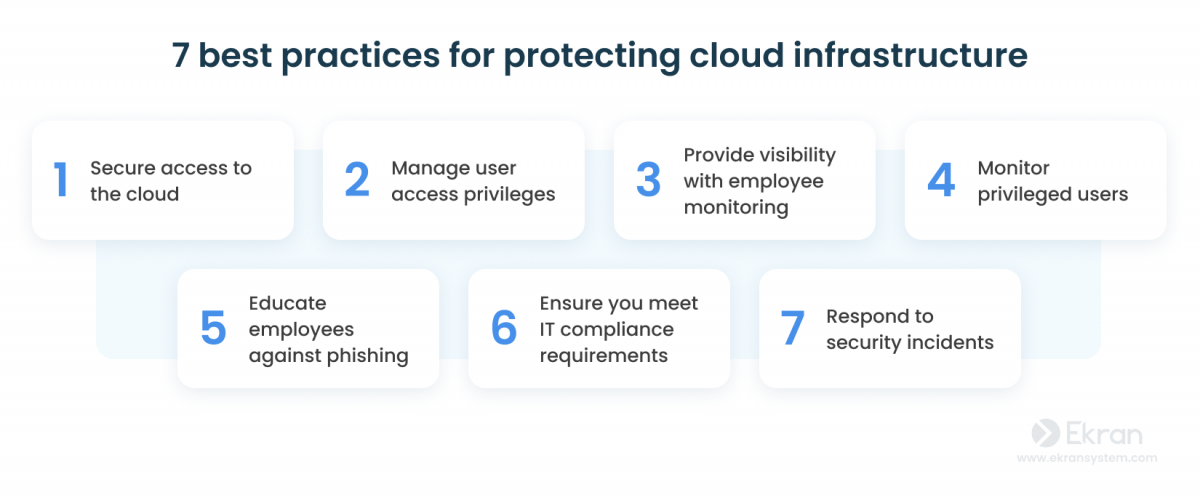Your organization might leverage cloud computing because of its practical advantages: flexibility, rapid deployment, cost efficiency, scalability, and storage capacity. But do you put enough effort into ensuring the cybersecurity of your cloud infrastructure?
You should, as data breaches and leaks, intellectual property theft, and compromise of trade secrets are still possible in the cloud. Cybersecurity risks in a complex cloud environment may make it hard to protect your data and comply with IT requirements of many standards, laws, and regulations.
If you wish to strengthen your cloud security, keep reading this post. We analyze the main weaknesses of the cloud and provide seven cloud infrastructure security best practices for securing critical systems and data in your organization.
What is infrastructure security in cloud computing?
Cloud security consists of different controls, procedures, and technologies to protect your organization’s critical systems and data against cybersecurity threats and risks stemming from cloud environments.
To better understand the weaknesses of the cloud environment, let’s take a look at its main security issues:


Large attack surface. It can be challenging to clearly define the boundaries of a company’s cloud environment. Systems and data might be attacked from many angles, including personal devices of remote employees, unauthorized third-party cloud applications and services, and public networks. Cloud data can be attacked both in rest and in transit.
Lack of visibility. Some cloud providers possess complete control over cloud IT infrastructure without exposing that infrastructure to their customers. Organizations using cloud computing platforms may struggle to identify their cloud assets to take proper measures in order to efficiently protect their data. Additionally, it may not be easy to track the activity of your employees in the cloud.
Complexity of environments. Certain organizations favor complex multi-cloud and hybrid environments due to their specific needs. This creates a problem of choosing the right cybersecurity tools that will operate both in the cloud and on-premises. Hybrid environments are challenging to implement and maintain and require a holistic approach to cybersecurity.
7 Real-Life Data Breaches Caused by Insider Threats
Despite these issues, most cloud service providers are good at protecting your data from outside cyberattacks. Yet there’s one aspect a cloud provider can’t fully cover in their cloud security infrastructure — the human factor. Even if a cyberattack is external, your workers are typically the ones who make it feasible.
5 major security threats in cloud infrastructure
To protect sensitive data in cloud infrastructure, consider the following major cybersecurity threats:


Account compromise
To gain access to sensitive data, a cyberattacker can take over an account of an employee, a privileged user, or a third party with access to your organization’s cloud environment. The attacker can use the compromised account to access systems and files, trick other users into disclosing sensitive data, or hijack an email account to perform further malicious actions.
An account can be compromised as the result of a brute-force attack, credential stuffing, password spraying, or simply poor password practices of the account’s owner. Cloud account takeover makes up 15% of all cloud security incidents according to the 2022 Cloud Security Report by Cybersecurity Insiders.
Social engineering
A cyberattacker may also trick an employee into providing access to critical systems and data. There are many social engineering techniques, among which phishing is the most used. It involves luring a victim to disclose sensitive information via email.
On behalf of a seemingly trustworthy source, a perpetrator may ask a victim to provide valuable data or take certain actions, such as changing a password. Once a deceived employee follows the link and types in their credentials, their account is compromised. A phishing email may also contain a malicious link or a file infected with a virus to get control over an employee’s computer and compromise sensitive data.
Reducing the Risk of Insider Threats among New Employees
Shadow IT
Employees in your organization may be unaware of the shadow IT meaning while installing and using cloud applications and services not authorized by the cybersecurity team. Unapproved software poses cybersecurity risks and challenges, including a lack of IT control over unauthorized applications, the possibility of unpatched vulnerabilities, and problems with IT compliance.
Moreover, compromised and abused cloud services might have extensive access rights in your cloud infrastructure. A cybercriminal can then use these rights to delete or exfiltrate your sensitive data.
Unintentional insider activity
Employees may be unwittingly responsible for data breaches, account compromise, and vulnerability exploits in organizations with low cybersecurity awareness. Careless workers and third parties with access to your cloud infrastructure can make mistakes, have poor password habits, share information via unauthorized cloud applications, or fail to follow other security precautions.
System administrators who neglect their duties are especially dangerous, as cloud misconfiguration accounts for 23% of all cloud security incidents according to the 2022 Cloud Security Report by Cybersecurity Insiders.
Malicious insider activity
Insider threats are just as common in the cloud as they are on-premises. In fact, insiders account for around 22% of security incidents according to the latest Verizon 2022 Data Breach Investigations Report.
A malicious insider may have different motives. They could be an outside agent performing industrial espionage, a malicious employee or a third party accessing sensitive data for personal gain, or a disgruntled worker seeking revenge on the company.
Malicious insiders in your organization can cause data loss, disrupt systems, install malware, and steal intellectual property.
The fundamental problem with insiders is that their malicious activity is tough to distinguish from basic daily activity, making it difficult to predict and detect an insider-related incident. Plus, malicious insiders usually have access to critical systems and data.
Now, when we discovered the key security threats in cloud infrastructure, let’s explore how to ensure data protection in your cloud environment.
Portrait of Malicious Insiders: Types, Characteristics, and Indicators
7 cloud security best practices to protect sensitive data
Cloud security combines different cybersecurity strategies, processes, and solutions. We’ve summarized the most efficient means of protecting your cloud computing environment in our seven cloud data security best practices:


1. Secure access to the cloud
Although most cloud providers have their own means of protecting their customers’ infrastructure, you are still responsible for securing your organization’s cloud user accounts and access to sensitive data. To reduce the risk of account compromise and credential theft, consider enhancing password management in your organization.
You can start by adding password policies to your cybersecurity program. Describe your employees’ expected cybersecurity habits, including having different and complex passwords for different accounts as well as regular password rotation. For a true shift in account and password security, you can deploy a centralized password management solution.
Consider Ekran System — a universal insider threat risk management platform with privileged access management (PAM) capabilities that will empower you to:
- Automate password management and delivery
- Securely store passwords in an encrypted vault
- Manually and automatically rotate passwords
- Provide users with one-time passwords
In addition to efficient password management, Ekran System can ensure a zero trust approach in your organization’s cloud infrastructure using two-factor authentication (2FA). It will allow you to verify users’ identities in your environment by asking users to type in codes sent to their mobile devices.
Did you know that having strong password management and multi-factor authentication is a requirement of various cybersecurity laws, regulations, and standards?
Two-Factor Authentication (2FA): Definition, Methods, and Tasks
2. Manage user access privileges
To ensure employees can perform their duties efficiently, some organizations provide them with extensive access to systems and data at once. Accounts of such users are a goldmine for cyberattackers, as compromising them can make it easier to access critical cloud infrastructure and escalate privileges.
To avoid this, your organization can regularly reassess and revoke user access permissions as part of the user privilege management process. Consider following the principle of least privilege, which states that users should only have access to data necessary to perform their job. In such a case, compromising a user’s cloud account will only provide cybercriminals with limited access to sensitive data.
In addition, your organization can control access permissions by having clear onboarding and offboarding procedures, including adding and removing accounts and their privileges.
Ekran System’s PAM functionality can help you implement the principle of least privilege in your cloud infrastructure, enabling you to granularly manage access privileges of your cloud user accounts and more:
- Grant access by request
- Provide users with one-time access
- Limit the period for which access is given
3. Provide visibility with employee monitoring
To increase transparency and secure the cloud infrastructure of your organization, you can use dedicated solutions to monitor your personnel’s activity. By watching what your employees are doing during work hours, you’ll be able to detect early signs of cloud account compromise or an insider threat.
Suppose your cybersecurity specialists notice a user logged in to your cloud infrastructure from an unusual IP address or during non-working hours. In that case, they’ll be able to react to such abnormal activity in a timely manner, as it indicates the possibility of a breach.
Similarly, if an employee is acting suspiciously by using forbidden cloud services or taking undesirable actions with sensitive data, monitoring can help you promptly detect this behavior and give you some time to analyze the situation.
You should also consider monitoring the activity of any external third parties such as business partners, suppliers, and vendors with access to your systems, as they may become another source of cybersecurity risks in your organization.
Employee monitoring capabilities in Ekran System can help you detect insiders’ malicious activity and signs of account compromise in your cloud infrastructure. With Ekran System, you’ll be able to:
- Monitor and record employee activity in a video format
- Watch live and recorded user sessions
- Search important episodes of user sessions by various parameters (websites visited, applications opened, keystrokes typed, etc.)
Ekran System can take your employee monitoring experience to the next level with the help of AI-powered technology. The user and entity behavior analytics (UEBA) module in Ekran System automatically creates a baseline of user behavior and compares it against real-time behavior to detect any anomalies. This functionality will allow you to detect suspicious activity without the help of humans. As an illustration, UEBA can notify your cybersecurity team if an employee tries to access your cloud infrastructure during non-working hours.
7 Best Practices for Building a Baseline of User Behavior in Organizations
4. Monitor privileged users
One of the key private cloud security best practices is keeping track of privileged users in your cloud infrastructure. Usually, system administrators and top management have more access to sensitive data than regular users. Consequently, privileged users can cause more damage to the cloud environment, whether maliciously or inadvertently.
When deploying your cloud infrastructure, it’s crucial to check if there are any default service accounts, as they’re typically privileged. Once compromised, these accounts will give attackers access to cloud networks and critical resources.
To reduce the risk of cybersecurity incidents and increase accountability, you can establish non-stop activity monitoring for all privileged users in your cloud infrastructure, including system administrators and key managers.
Ekran System’s PAM and user activity monitoring (UAM) capabilities can help you secure your cloud infrastructure from risks posed by privileged accounts. Ekran System will allow you to:
- Monitor privileged users’ activity in your cloud environment
- Manage access permissions of privileged user accounts
- Export monitored data using a series of customizable reports
5. Educate employees against phishing
Monitoring user activity is not the only way to minimize the influence of the human factor inside your organization. To protect your cloud infrastructure even more, you can raise your personnel’s cybersecurity awareness, with a particular emphasis on phishing.
Even the most sophisticated anti-phishing systems can’t guarantee the required level of protection. A recent study of 1800 phishing emails sent to employees of a company in the financial sector showed that 50 emails bypassed the email filtering service. Fourteen users opened the malicious email, which launched the malware. Although thirteen installation attempts were denied, one person managed to install the malware. In reality, even one incident can be enough to infect and compromise the whole system.
You can teach your employees about signs of phishing and social engineering to avoid disclosing sensitive information. Regular cybersecurity trainings and seminars are the best protection as phishing attacks evolve in method and number.
The biggest mistake in phishing education programs is training without real-life simulations. A simulation should feel like an actual phishing attack, and employees should be unaware of the impending test. You can then track simulation results and determine which employees need further training.
Ekran System’s monitoring functionality can help you protect cloud infrastructure from phishing by allowing you to:
- Watch recorded sessions of your employees to analyze their behavior during a simulated phishing attack
- Detect and stop unusual behavior if an employee’s account is compromised due to phishing
Insider Threat Awareness: What Is It, Why Does It Matter, and How Can You Improve It?
6. Ensure you meet IT compliance requirements
Cybersecurity compliance with standards, laws, and regulations aims to protect consumers’ data and provide general guidance for organizations to better secure sensitive data. Without the right security controls and tools in your cloud infrastructure for IT compliance, your organization may lose millions of dollars in fines in case of a data breach.
Prominent cloud computing providers are aligned with the most known compliance requirements. However, organizations using these cloud services still have to ensure their own data processes and security are compliant. Given the lack of visibility in ever-changing cloud environments, the compliance audit process is not easy.
To meet IT compliance requirements, you must first define which standards pertain to your industry and which your organization must meet. For instance, following SWIFT Customer Security Programme (CSP) requirements is mandatory for each financial organization that uses SWIFT services. Similarly, any organization that stores customer data in the cloud must follow SOC 2 compliance requirements. To easily identify the requirements that your organization must meet, consider hiring a data protection officer (DPO) who will provide you with expert knowledge in cybersecurity and IT compliance.
Deploying Ekran System in your cloud infrastructure can help your organization meet the requirements of the following cybersecurity standards, laws, and regulations:
7. Efficiently respond to security incidents
Losses from a data breach can increase if you can’t quickly detect, contain, and eradicate cybersecurity threats. The longer a threat remains in your cloud environment, the more data an attacker can exfiltrate or delete.
On the contrary, a fast response to a cybersecurity incident can limit the extent of damage. Consider developing an incident response plan to ensure your cybersecurity team can act efficiently in an emergency. This plan must have strict roles and procedures outlined for different scenarios.
Additionally, you can use Ekran System’s user activity alerts and incident response capabilities to detect and respond to cybersecurity incidents in your cloud infrastructure quickly and efficiently. With Ekran System, you’ll be able to:
- Automatically detect suspicious account activity that may signal account compromise with the help of our AI-powered UEBA module
- Receive email notifications about potential cybersecurity incidents based on a variety of alert rule parameters such as visited web resources, launched process names, and connected USB devices
- Manually or automatically respond to an incident by blocking a user, notifying them of unauthorized activity, or killing a suspicious process
If a cybersecurity incident happens in your cloud environment, Ekran System can also provide you with evidence by exporting related monitoring data in a protected standalone format.
Security Incident Investigation
Conclusion
The specifics of cloud computing result in certain cybersecurity complications. Extensive attack surfaces and lack of visibility in complex cloud environments increase the likelihood of cloud account compromise, successful phishing attacks, and insider activity.
Use our seven cloud network security best practices as a checklist to protect your cloud infrastructure from potential cybersecurity incidents and secure your organization’s sensitive data. Efficient cloud infrastructure security includes securing access to your perimeter, limiting access privileges, and monitoring the activity of regular and privileged users. To reduce cybersecurity risks, you can also raise employee awareness about phishing attacks and prepare a response plan for possible security incidents.
For those wondering how to secure cloud infrastructure, Ekran System might be the answer. Ekran System supports Microsoft Azure and Amazon Web Services private clouds and more.






